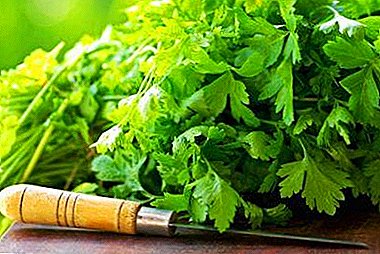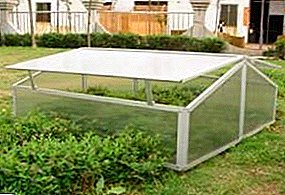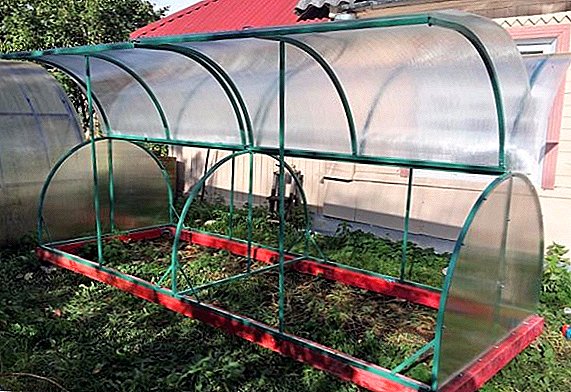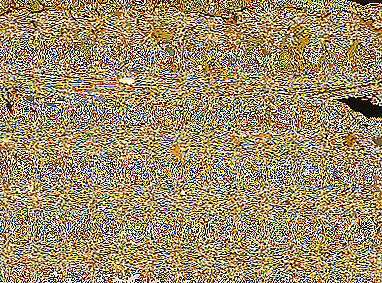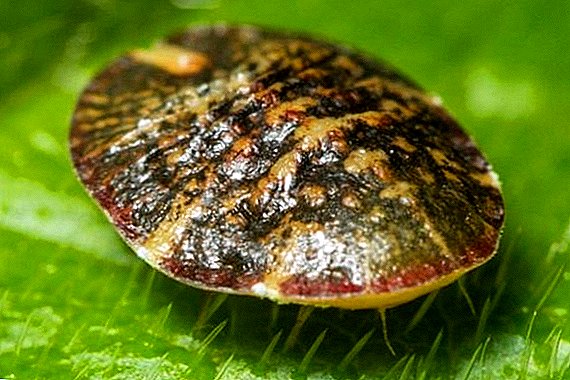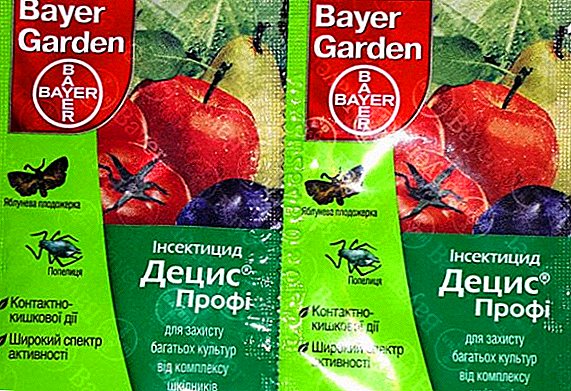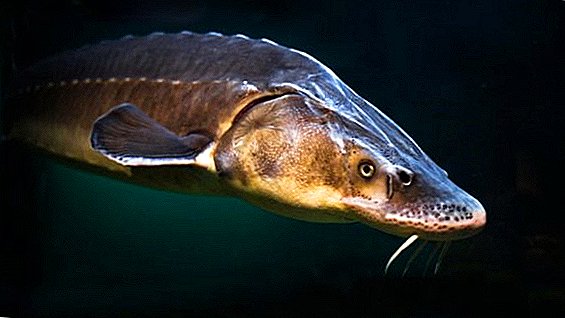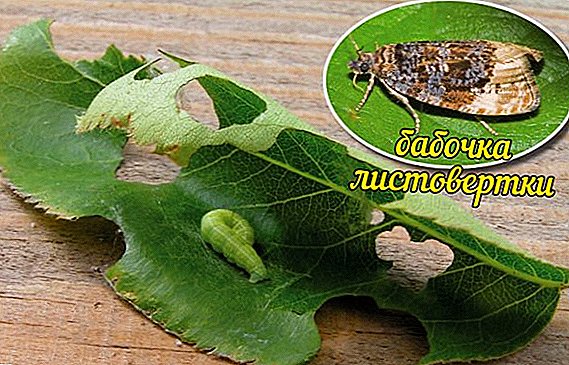 One of the most dangerous pests that gardeners encounter when growing pear trees is the insect moth. This pest is able to hit virtually the entire surface of the plant in a very short time. Pearsheet requires efficient, immediate and, most importantly, crop-safe methods of dealing with it.
One of the most dangerous pests that gardeners encounter when growing pear trees is the insect moth. This pest is able to hit virtually the entire surface of the plant in a very short time. Pearsheet requires efficient, immediate and, most importantly, crop-safe methods of dealing with it.
How to recognize a pest
Sheet wrench (Latin Tortricidae or Olethreutidae) is a family of butterflies, which has more than 1000 genera and 10,000 species of insects.
An adult individual resembles a moth or a mole of various colors, closer to gray-brown, with a wingspan of not more than 2.5 cm. The thick body and wings of the butterfly are covered with hairs and gray wax bloom. Caterpillars of the insect reach 2 cm in length, have 8 pairs of legs and almost no covering bare body with rare stripes. The color of the caterpillars can be from yellowish-pink to green, and the head is black or brown. It is the butterfly larva that causes enormous damage to plants.  Pears are dangerous types of listworms: pear, apple, plum, grapevine, eastern, oak, rosacea, hawthorn and frost.
Pears are dangerous types of listworms: pear, apple, plum, grapevine, eastern, oak, rosacea, hawthorn and frost.
Eating leaves, the larvae fold them into tubes or turn them into a shapeless lump. If the insect is disturbed, it bends sharply, slips out of the leaf and hangs on the cobweb-like thread.
Learn how to get rid of other pests of the garden: gall mite, gold-eyed, thrips, snakes, cockchafer, scoops, wasps, tsikadki, ants, centipedes, granary weevil, mice, aphids, shrews, Colorado potato beetle, earwig.
Life cycle
Small pests are able to destroy the entire crop, eating young shoots and not letting the buds begin to knot. The level of winter hardiness of trees depleted by insects is significantly reduced. Moreover, the vital activity and wrecking of the caterpillars begins with the spring thaw and lasts the entire hot season.
In spring, the caterpillars attack the inflorescences, damaging the buds and buds, while weaving them with cobwebs. Later, they move onto the leaves, coiling into them to form cocoons with the help of cobwebs. Insects pupate in early July. Two weeks later, butterflies appear.  During one season, pests can produce several generations. Adults of some species (such as rosacea, hawthorn and frost) over the summer lay eggs on a pear for the next year. The rest of the caterpillars survive the winter safely, leaving cocoons in the cracks of the bark or on the branches of the tree.
During one season, pests can produce several generations. Adults of some species (such as rosacea, hawthorn and frost) over the summer lay eggs on a pear for the next year. The rest of the caterpillars survive the winter safely, leaving cocoons in the cracks of the bark or on the branches of the tree.
Achieving high numbers, insects destroy ripe fruits.
Did you know? Just like spiders, caterpillars can secrete a thread from a pair of silk-secreting glands. The secreted mucus when in contact with air forms the thread necessary for the formation of a cocoon, the binding of leaves or the weaving of cobwebs.
Signs of defeat
One of the signs of damage to the pear harmful insects is a sticky liquid flowing down the branches and trunk. Another important sign is the leaves twisting transversely to the central vein. They begin to darken, becoming almost black.
Inside the leaf tubules are the insect larvae, their excrement and the remnants of the cocoons from the turned moths.  Fruits affected by a leafworm may further suffer from a disease such as fruit rot, therefore, it is necessary to get rid of the pest at the first signs of its occurrence.
Fruits affected by a leafworm may further suffer from a disease such as fruit rot, therefore, it is necessary to get rid of the pest at the first signs of its occurrence.
This insect is capable of destroying 80% of the crop and more than half of the leaves of the trees, if measures for its destruction are not taken.
Important! Having settled on a pear, the caterpillar can parasitize on other nearby fruit trees, such as cherries, plums, hawthorn, bird cherry and many others. Therefore, to combat the pest it is necessary to make a full garden processing.
Prevention and "active" struggle with the enemy
The appearance of a moth on a pear is a big nuisance for every gardener, so it is important to understand what preventive measures can be used to prevent the appearance of caterpillars, how to deal with them, if the problem has already appeared than to process trees without harming the plants.
Preventive spraying
In early spring, it is necessary to clean the bark of the trees from dead fragments and treat the shafts with a solution of milk of lime and copper sulphate or Karbofos (2%). It is very important to protect the pear from mechanical damage and frost cracks.  The first chemical prophylaxis is carried out directly after cleaning and whitewashing trees, before the sap flow begins. The air temperature favorable for processing should be above 10 ° C in order for the larvae, hiding deep under the bark from the cold, to crawl out. The first spraying, as well as two subsequent ones - before and after flowering, is carried out with the preparations "Kinmiks" and "Decis".
The first chemical prophylaxis is carried out directly after cleaning and whitewashing trees, before the sap flow begins. The air temperature favorable for processing should be above 10 ° C in order for the larvae, hiding deep under the bark from the cold, to crawl out. The first spraying, as well as two subsequent ones - before and after flowering, is carried out with the preparations "Kinmiks" and "Decis".
Before flowering, treatment can also be carried out by means of: "Atom", "Di-68", "Rogor-S", "Landing", "Zolon". During the period of growth and ripening of fruits, in addition to these insecticides, the treatment can be carried out by means of: “Tsitkor”, “Fury”, “Kemifos”, “Iskra”, “Karbofos”.
In the autumn, after leaf fall, the leaves need to be collected, loosened the earth of the near-barred circle and process the pears and the soil under them with copper sulphate or Bordeaux mixture. 
Agrotechnical receptions
The security of any plants, including pears, is a complete care for them. Weakened, diseased or neglected crops become victims of diseases and pests. It is very important to observe the agrotechnology, timely weeding, pruning, watering and fertilizing garden crops.
The crown of the pear should not grow uncontrollably, and the amount of moisture and dressing cannot be excessive or lacking, as this will harm the plant. 
Important! The soil in pristvolnyh circles should be loose, not containing weeds that attract pests. Systematic cleaning of fallen leaves and fruits, especially those affected by insects, will limit their distribution in the garden.The systematic collection of fallen leaves and fruits throughout the season, the removal of leaves infested with moth leaves, shaking off larvae from leaves, hanging traps and tying trunks with trapping belts are mandatory pest control measures to preserve the crop.
An acceptable biological method of fighting the caterpillar is to attract birds to the site of natural enemies.
Preparations
The most effective way of dealing with moths and butterfly moths is chemical.  However, two important points should be considered:
However, two important points should be considered:
- preparations must be alternated for the reason that insects quickly adapt to the toxicity of chemical agents;
- poisonous substances, settling on the fruit, can get into the human body.
To resort to this method of insect control is necessary if their number exceeds the permissible harm threshold - when more than 5 harmful individuals are found on one branch.
Important! It should be remembered that the treatment should be carried out at a temperature not lower than 10 ° C and cover the entire territory of the garden, since the moth easily moves through the plants.
Effective biological products include: "Bitoxibacillin", "Lepidotsid", "Fitoverm". The most famous pyrethroids used against the tracks: "Fastak", "Qi-Alpha", "Accord", "Ivanhoe", "Alfatsin", "Fatrin". 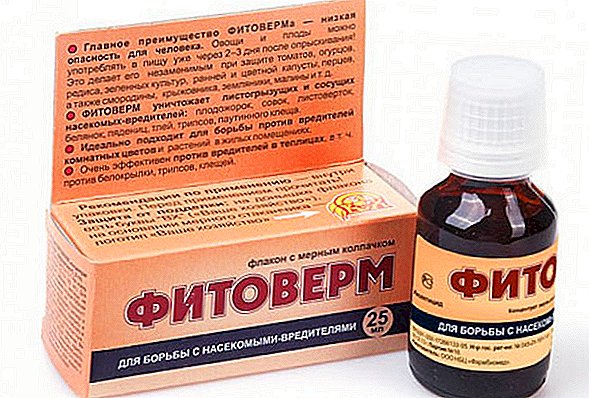 The use of such means is possible: "Karate Zeon", "Kungfu", "Sensei", "Karachar", "Lyambdeks", however, it should be remembered that when the air temperature is above 25 ° C, the effectiveness of pyrethroid preparations is significantly reduced, and provoke a tick breeding outbreak.
The use of such means is possible: "Karate Zeon", "Kungfu", "Sensei", "Karachar", "Lyambdeks", however, it should be remembered that when the air temperature is above 25 ° C, the effectiveness of pyrethroid preparations is significantly reduced, and provoke a tick breeding outbreak.
Did you know? During the first 56 days of life, the caterpillars are able to eat so much vegetation that their size increases by 20,000 times the initial weight during this period.
Folk recipes
For folk remedies to combat the leaflet, use such accessible and most harmless to humans recipes:
- tobacco infusion - 500 g of tobacco dust must be poured 10 liters of boiling water, insist 24 hours, strain and pour water in a ratio of 1: 1. Immediately before use for every 10 liters of the resulting solution, add 50 g of liquid or crushed soap. Do not allow ingestion of mucous infusion, due to its toxicity;
- decoction of wormwood - 800 g of dry grass wormwood pour one bucket of water and insist for two days. Then boil for half an hour, cool and bring the broth to a volume of 10 liters. Immediately before use, dilute with water 1: 1.
- infusion of potato tops - 4 kg of fresh or 2 kg of dry tops chop and pour 10 liters of warm water, let it brew for 4 hours. Then strain and add 40 g of liquid soap.
- decoction of tomato tops - 4 kg of fresh tops and roots pour 10 liters of water, leave to stand for 4 hours, then boil for at least half an hour. Cool and strain. Before use, dilute with water 1: 1 and add 40 g of soap.




Butterfly traps are made from bread kvass, dried fruit compote or fermented jam filled with a third can and hung from a tree at a height of at least 1.5 meters overnight. Morning traps must be removed to avoid the ingress of beneficial insects.
Prevention and control of leaflets should be comprehensive, complete and timely. This will help preserve the health of garden trees and preserve the desired harvest.


